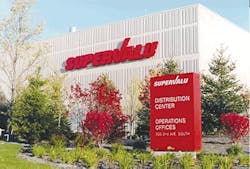Energy Saving Opportunities
Unlike other essentials such as food or water, large-scale electrical power cannot be stored; it must be used as it’s generated. Opportunities in the energy market are prompting industrial facilities and other companies to implement technologies and initiate programs that save them money through smart purchasing strategies, effective energy management, and automated energy curtailment. Some of these same companies are also profiting by effectively “selling” electricity back to their utilities when demand is high.
Minnesota-based grocery retailer Supervalu (www.supervalu.com) used energy monitoring hardware and partnered with a energy curtailment service provider (CSP) and a systems integrator specializing in refrigeration to reduce overall energy consumption in its distribution centers and make them more energy efficient.
Supervalu, serving customers through a network of store brands that include CUBS, Jewel-Osco and Albertsons, is an environmentally conscious grocery chain, as evident in the company’s stated goal to cut emissions of greenhouse gases by 10 percent by the end of 2012. Richard Druce, director of facilities maintenance, says that the company also is focused on reducing energy consumption in its distribution centers, each of which encompasses 40,000-500,000 square feet of refrigerated space.
To meet these goals, Supervalu enrolled in a demand-response program and worked closely with Net Peak Energy Group, LLC (www.netpeakenergy.com), an energy data aggregator and curtailment services provider. Net Peak helps by gathering and analyzing energy usage data. The company also helps businesses match their loads with the various demand-response programs available from utilities.
Multi-faceted demand response
“Supervalu’s demand-response program is multifaceted,” says Net Peak General Manager Fred Krumberger. “By participating in a ‘capacity’ program, the company agrees to a potential interruption in service up to 10 times per year. In most service areas, however, companies experience no emergency interruptions.”
Krumberger says that capacity programs currently offer payments between $40,000 and $60,000 per megawatt hour and that customers receive their payment even if their capacity is never actually reduced. If there is an emergency curtailment, the power grid operator compensates the company in the range of $900 – $1,000 per megawatt hour for the curtailment period.
“The emergency energy [curtailment] program in which Supervalu participates calls for its distribution centers to shed up to 1.2 megawatts of power,” says Net Peak’s President Mike Verkuylen. “We’re typically able to provide one to two hours of advanced notice to initiate the emergency load shed.”
Net Peak provides this and other notifications through its network operating and dispatch center located in Green Bay, Wis. Here, NetPeak’s Dispatch Specialists use custom designed interfaces for real-time monitoring of Supervalu’s energy consumption. Detailed energy data comes from a hardware appliance called an OptoEMU Sensor developed by Opto22 (www.opto22.com). The OptoEMU Sensor provides the physical connections needed to remotely monitor and acquire real-time energy data from a variety of systems, then sends the data to network databases and Web-based applications. At Supervalu, the sensor monitors both pulse-emitting devices (such as utility meters and sub-meters) and the voltage and current of several load panels, chillers, and refrigeration units. All communication takes place over the Internet via standard TCP/IP.
Net Peak also tracks weather and other events affecting the energy market, including the real-time market price of electricity. As energy demand peaks, market prices rise, and when Supervalu’s agreed upon price is reached, curtailment begins. Krumberger says that these types of economic curtailments are typically much shorter than emergency curtailments.
“During periods such as this, the payments received for curtailment essentially amount to ‘selling’ electricity back to the power grid operator. If, for example, we have a customer that pays $50 per megawatt hour for its electricity, and the market price rises to two, three, or even four hundred dollars a megawatt hour, the business would want to capitalize on a price that high. By monitoring real-time market prices—and working within the pre-arranged dispatch rules and strike prices established in conjunction with the company’s engineers and operators—we’re able to generate revenue for the customer.”
Automated response technology
Once notified by Net Peak, Supervalu needs to quickly take action and begin curtailment, which means they need technology that will provide an automated response to curb power demand. Systems integrator Advanced Energy Control (AEC) (www.advancedenergycontrol.com) designed and implemented a hardware system programmed to intelligently control the refrigeration system.
Explains AEC’s Nathan Bartlett, “We were brought in to design and build a system that provided better sequencing of the refrigeration system and broader, more comprehensive and more powerful demand-response automation in general.”
To achieve precise levels of control and automation, AEC installed additional Opto 22 components. The company’s SNAP PAC System (programmable automation controllers and I/O) utilizes integrated circuit temperature detector (ICTD) sensors to monitor temperatures, and analog and digital output signals to expertly manage compressors, control solenoids on evaporators and switch relays. Bartlett says that the AEC-designed control system can provide interfaces to any piece of industrial-grade equipment. In this case, the system handles about 1,500 inputs and 500 outputs, enabling full demand-response automation of Supervalu’s industrial refrigeration, ventilation, and soon, even the HVAC and lighting systems.
For Supervalu’s Pennsylvania distribution centers alone, the return on investment resulting from the energy management initiatives are twofold. First, payments and savings for the demand-response participation and curtailment will generate approximately $75,000 to $115,000 in annual revenue. Secondly, AEC’s new monitoring and control systems have led to more efficient cooling and an overall reduction in the facilities’ energy consumption everyday. This has resulted in an estimated energy savings of more than $155,000 per year.
Advanced Energy Control
www.advancedenergycontrol.com
Net Peak Energy Group
www.netpeakenergy.com
Opto22
www.opto22.com
Supervalu
www.supervalu.com

